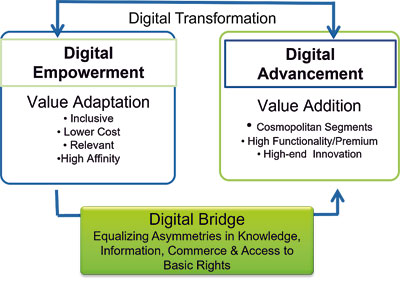Theory of Inclusion – Part ii
View(s): As stated last week, this article is the continuation of the article published last week which stressed the importance of Inclusiveness as a business strategy. Last week’s article was based on Dr Hans Wijayasuriya’s oration delivered at the second biennial oration of Late Professor Liyanage that took place at PIM on the 10th August 2021.
As stated last week, this article is the continuation of the article published last week which stressed the importance of Inclusiveness as a business strategy. Last week’s article was based on Dr Hans Wijayasuriya’s oration delivered at the second biennial oration of Late Professor Liyanage that took place at PIM on the 10th August 2021.
Enablers of Inclusiveness
Explaining the fundamental market insights which are the base of the Theory of Inclusion, Dr Hans stated that the “customer space duality pervades structural and behavioural dimensions of the Inclusion opportunity”.
Comparing Top of The Pyramid (TOP) and Middle (MOP) and Base of the pyramid (BOP), he has identified the former as a slow-growth segment which demonstrate; global influences, homogenous andcosmopolitan features whereas the latter would be more Fast-Growing which consists of heterogenous consumers who represent the mass market therefore, there’s opportunities for rapid expansions. What needs to be understood here is that there are no poor-man brands hence there is no need to position something to the BOP (Bottom of the pyramid) instead, the offer must be more aspirational so that even the ones from the BOP would feel they are a part of it (Inclusiveness). Therefore, service fragmentation to the smallest unit of production is fundamental to Inclusion which can only be backed by technology as it needs to eliminate minimum spend, minimum cost of entry and under utilisation of resources in the context of mobile communication services sector.
 In other words, the profits are made with increased volumes rather than being bogged down to per unit margins. At the same time, technology would act as a social leveler which makes equal grounds for people in every tier of the pyramid consume what they want.
In other words, the profits are made with increased volumes rather than being bogged down to per unit margins. At the same time, technology would act as a social leveler which makes equal grounds for people in every tier of the pyramid consume what they want.
Therefore, technology is the true enabler of this paradigm shift as it makes life easier and make things available for mass majority without limiting it to the affluent niche. In a nutshell, it’s about an opportunity in bridging the gaps in the nation than division.
From Inclusion to Nouveau Socialism
Thinking beyond making business sense can make better sense of many other aspects of our lives, including national politics if the theory of inclusion can be in the center of all decision making. Socialism is defined as a political and economic theory of social organisation which advocates that the means of production, distribution, and exchange should be owned or regulated by the community as a whole.
In other words, (in Marxist theory) a transitional social state between the overthrow of capitalism and the realisation of Communism. This leaves us with the question; is inclusiveness a fundamental right? To answer this question, we should look at what a country or society can miss in the absence of inclusion or rather exclusiveness.
Absence of inclusion or presence of inclusion can create; disparity, exploitary politics, selective inclusion and in the end instability and disharmony.
Therefore, understanding theory of inclusion is not only important to business leaders and marketers but also is important for national leaders and policy makers.


